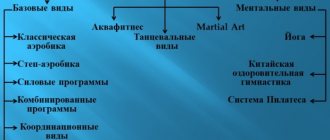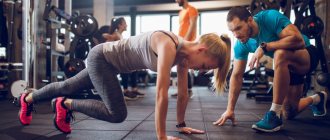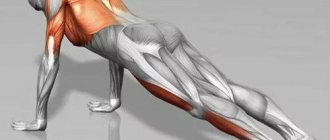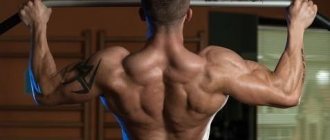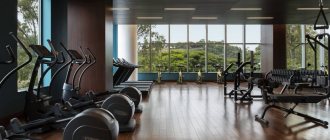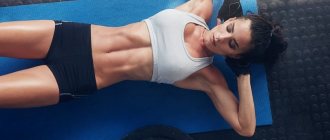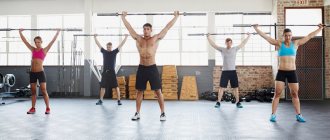Group training is classes in fitness clubs that are conducted in groups under the guidance of an instructor. Group training can be of completely different sports types: from simple Pilates to high-impact CrossFit.
Have you decided to attend group training and can’t decide which direction to choose? Or just lost in the fitness club schedule, which contains many unfamiliar names? We offer you a unique, very detailed selection of types of group training with descriptions and photos.
See also:
- Top 20 Best Women's Fitness Shoes
- Proper nutrition: where to start step by step
Pros and cons of group fitness classes
Pros:
- They allow you to conduct training in an interesting and useful way.
- Since these are group classes, there is always an incentive to perform this or that exercise along with the advanced ones, especially when the trainer does not “get away with it.”
- Each direction is effective in its own way, one allows you to lose weight, the other strengthens muscles and ligaments, the third makes the body flexible. There is a load to suit everyone's taste.
Minuses:
- The disadvantages of group exercises are the constant pace and non-stop load, which means that the exercise cannot be completed whenever you want. Such activities require discipline, perseverance and a strong cardiovascular system.
- Not all types of exercises are aimed at the same goal, that is, not every exercise can help you lose weight or gain muscle mass, so you need to understand the specifics of the chosen direction before you start training.
Dance classes
Activities that not only help you lose weight and develop coordination, but also allow a person to train with pleasure, and you can also learn something new from them. By the way, it is not uncommon for fitness club visitors to become good dancers! But even here you need to understand that lessons are different - for people with different backgrounds. As a rule, if a client wants to start training at a more serious level, he goes to special dance schools, because fitness clubs are still more aimed at training to maintain health.
Photo: portal Moscow 24/Alexander Avilov
Types of group classes in a fitness club
Aerobic directions
- Aerobics is a type of fitness in which simple dance movements are performed to rhythmic music. Aerobic movements became the basis for other areas of fitness. More about aerobics →
- Step aerobics - in the first part of the lesson, dance sequences are performed on step platforms. The second part is the strength part, in which, with the help of fitness equipment, muscle groups that have not received load are additionally worked out. More about step aerobics →
- Aqua aerobics – based on aerobic movements, as well as various exercises for all muscle groups that are performed in water. Aqua aerobics is safe compared to previous options.
- Tai-bo is an aerobic fitness movement based on boxing strikes, Muay Thai and kickboxing movements. Rhythmic exercises quickly get the body in shape and strengthen the cardiovascular system. Read more about tai bo classes →
- Bosu - aerobic movements in the form of ligaments are performed on a special rubber hemisphere on a rigid base. Thanks to the instability of the position, deep stabilizer muscles are trained.
- Cycling is a group training that takes place on cycles and simulates cycling over rough terrain and uphill. The main part of the lesson is changing the load and riding speed, the final part is strength exercises for all muscle groups. Read more about cycle training →
- Fitball is a direction in which movements and exercises are performed on a fitness ball - a fitball, which allows you to train all muscles, even the deepest ones, while holding the body on a rolling ball.
- Shaping is a trend that originated in Russia, designed for the development of the whole body, taking into account the physiology of the female body. More about shaping →
Power directions
- Functional Training - Strength training using a variety of fitness equipment allows you to train most aspects of physical performance - strength, endurance, flexibility, agility and coordination. Read more about functional training →
- CrossFit is a popular sport that is adapted to a fitness format. For CrossFit, there are specialized gyms and equipment that is non-standard for other areas of fitness. Read more about CrossFit →
- Boxing is a workout that is performed in an aerobic style using special boxing equipment in the form of a pear. The main movements are striking the punching bag with your hands and feet.
- Body pump is a strength training aimed at strengthening all the muscles of the body using a fitness barbell. The patented methodology has many training programs that are constantly being improved and changed. Read more about Body pump training →
- Body sculpt is a complex of areas that includes strength training that develops different parts of the body. For example, Upper body is aimed at developing the shoulder girdle, Butt+fleks – gluteal muscles and hips. Read more about Body scalp →
- Martial arts - various areas in a fitness format, which include elements of Thai boxing, Ku-Do, karate, kickboxing, taekwondo. Read more about the fit-bo direction →
Intelligent body
- Oxysize is a “Body and mind” direction in which static exercises are performed with a special breathing technique that promotes fat burning. Read more about oxysize →
- Yoga , or more precisely Ha-Tha yoga, is a set of asanas aimed at developing flexibility of the whole body, joint mobility, strengthening muscles and ligaments. It also includes breathing exercises - pranayama.
- Pilates is a healing practice for all ages, regardless of gender. The direction has a positive effect on the body as a whole, helping to improve the functions of the musculoskeletal system. Read more about Pilates →
- Port de Bras is a dance style that incorporates elements of choreography performed to calm music in the style of Pilates. Classes work deep muscles, make the body more flexible, and movements smooth and graceful. Read more about port de bras →
- Stretching - includes muscle stretching exercises performed both statically and dynamically. Stretching helps relax tight muscles, increases the flexibility of ligaments and fibers, improves blood circulation and strengthens muscles. More about stretching →
- Callanetics is currently not so popular, but is still found in fitness clubs and is a set of exercises performed in static tension. More about callanetics →
- Aeroyoga – classes take place in special hammocks, allowing you to completely relax your body and perform exercises in zero gravity.
- Qigong is a gymnastics based on Taoist practices, performed for health purposes.
Aerobic lessons
These are dynamic classes accompanied by music. As a rule, this includes a number of basic movements that are combined into bundles, but this largely depends on the specific class. More often, such classes are attended by women, but men also do not shy away from aerobics. There are several advantages to such activities:
- They motivate better, since you work out in a group and always with a trainer;
- it is much more fun and interesting than training on cardio equipment;
- coordination of movements develops better;
- This is an effective way to combat excess weight.
Photo: Portal of the mayor and government of Moscow
It is important to understand that if you are a beginner, then you need to start with lessons for beginners. It was not for nothing that I immediately said that in different networks the same lessons can be called differently: there are a large number of aerobics options - from simple movements on the floor to step aerobics, as well as lessons with elements of striking techniques (for example, tai-bo ) or advanced classes, for example, cycling (imitation of a bicycle race on special simulators).
Therefore, before signing up for any class (even if the name seems familiar to you), be sure to consult with the manager or fitness consultant of the club. Find out exactly what set of exercises is included in the lesson and find out if it is right for you.
Defining the Goal
Determining the goal of group strength training for women is the first thing to do before starting exercise. The goal affects every aspect of the workout: its type, frequency, duration, load selection. The lack of a goal leads to the fact that it becomes more difficult to mobilize efforts, and, as a result, the effect does not appear as quickly as we would like.
You can do various types of group strength training without a goal, if you just want to improve your overall physical fitness, improve your posture and increase muscle mass, and increase your endurance.
For even better results, you should clarify your aspirations. Not only determine why you should train, but also what specific effects you want to achieve, for example, reducing your waist by 5 cm or enlarging your buttocks, and so on.
Warm-up
Group strength training usually consists of intense exercises that significantly tax the entire musculoskeletal system. Without warming up, muscles, tendons and ligaments are more susceptible to injury, and, in addition, all exercises become less effective. To avoid the negative consequences of group strength training, you need to prepare your body for the load by doing at least a 10-minute warm-up. Half should be cardio-type exercises (eg running in place, jumping, riding a stationary bike), and the other half should be focused on specific body parts (eg squats to warm up your leg muscles, etc.).
Effective load
Adjusting the load according to your body's capabilities is a key issue that determines the rate of progress in training. A load that is too low can delay the appearance of exercise results, while a load that is too high can lead to overtraining and a complete stop in muscle growth.
In general, it is believed that one moderate-intensity group strength training session should not last longer than 30 minutes (not counting the warm-up). Repetitions should be performed as many as required to complete the series before complete impotence (i.e., if you do not have enough strength to perform the tenth repetition technically correctly, you need to do 9 full repetitions). One series should not contain more than 15 repetitions for large muscle groups and 20 repetitions for small ones. However, these are rough guidelines. It is always best to set rules in consultation with a personal trainer.
Low Impact Workouts
These are activities where there are no sudden, intense movements and shock loads on the joints and spine. Such training is attended by completely different categories of people, especially since some of the directions are not only training, but also a certain philosophy. This could include, for example, yoga classes. Pilates is suitable for people who have problems with the spine and coordination; in addition, these classes will also appeal to those who love calm movements and static loads.
Low-impact lessons also include classes to develop stretching - stretching. And joint gymnastics is ideal for people of the older generation, because joint mobility is impaired with age.
Kanevsky Eduard
Correct breathing
Proper inhalation and inhalation can make high-impact training much easier and therefore more effective. You need to remember that before approaching you need to draw more air into your lungs. At the moment of lifting, you need to exhale, in the final phase of the movement - hold your breath for a second, and then inhale again while lowering the weight.
